Microsoft Surface Pro 3 Review
by Anand Lal Shimpi on June 23, 2014 3:55 AM ESTBattery Life
Microsoft made no sacrifice in battery capacity in pursuit of Surface Pro 3's thin chassis design. The new tablet features an integrated 42Wh battery just like the previous two models. Charging duties are handled by an external 31W charger with a brand new magnetic connector. Microsoft never seemed to get a good MagSafe clone working in the previous models, so Surface Pro 3 abandons the previous design entirely in favor of something a bit more sensible.
The new connector no longer looks like an oversized MagSafe connector, and instead features a thin plastic insert that mates with the charge port on Surface Pro 3. Charge time hasn't changed, you can fully charge the device in around 2.62 hours:
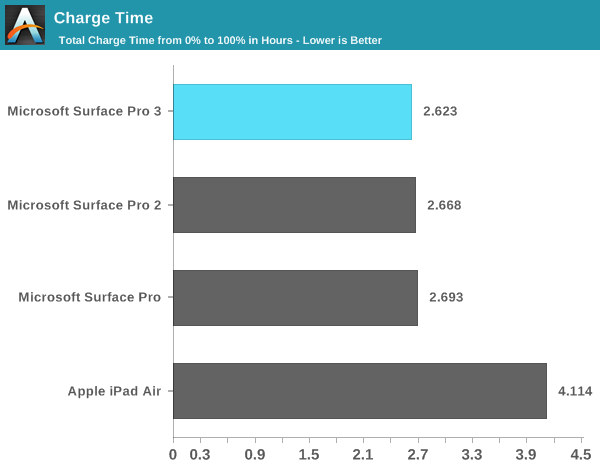
The device-side connector features 40 pins but you only need 12 of them to charge the device. The remaining pins are used for Gigabit Ethernet, USB, DisplayPort (up to 4096 x 2304) and audio. Microsoft seems hell bent on avoiding Thunderbolt at all costs so instead of embracing the standard it has created a custom alternative of its own doing. The benefit to Microsoft's connector is it can obviously deliver more power than Thunderbolt can, the downside is that it can't send PCIe and thus you don't get support for any ultra high bandwidth external storage devices. I still would rather see Microsoft implement Thunderbolt as there's at least an existing ecosystem built around that but here we are three generations into Surface and if we haven't seen it by now I don't think we're ever going to.
The supplied power adapter includes a USB charge port capable of delivering 1A at 5V.
As Surface Pro 3 is designed to be both a laptop and a tablet I've run it through both our Windows laptop battery life tests and our tablet battery life tests.
Laptop Battery Life
As a laptop, Surface Pro 3 delivers comparable battery life to other optimized Haswell ULT designs. I threw in Sony's Vaio Pro 13 into the mix because it has a similar sized battery (37Wh vs. 42Wh) and is one of the most power efficient Windows Ultrabook platforms on the market. Surface Pro 3 manages to deliver similar battery life, which means it's a little less power efficient but the two are within the same range at least.
Compared to Surface Pro 1 and 2, Surface Pro 3 at worst delivers similar battery life and at best increases range on a single charge by up to 20%. We're looking at 3.75 hours - 7.6 hours of notebook usage on a single charge depending on usage.
It's worth noting that there's a substantial advantage in battery life if we look at the 13-inch MacBook Air running OS X. I only mention this because of Microsoft's insistence on comparing Surface Pro 3 to Apple's popular line of notebooks.
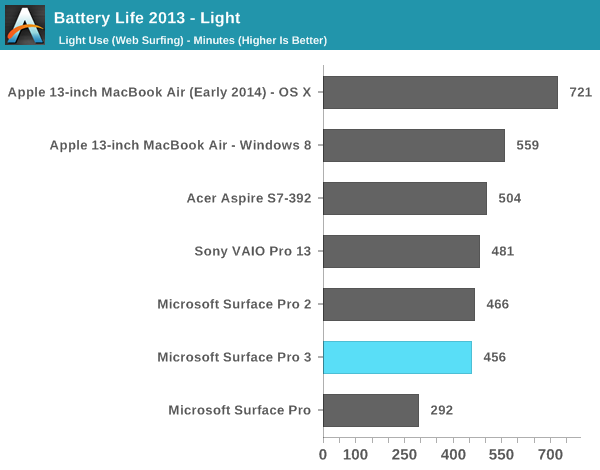

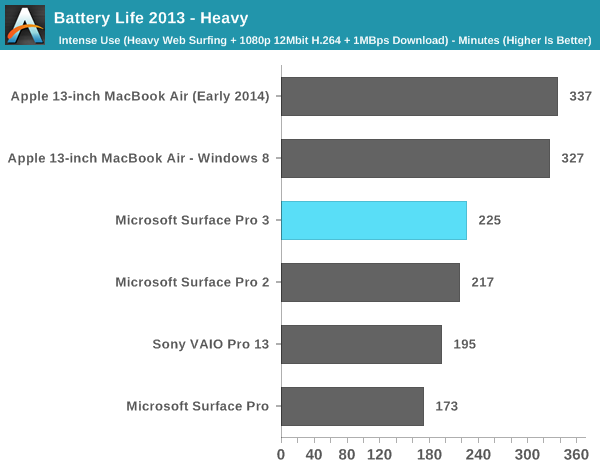
Tablet Battery Life
Tablet workloads are going to be far more display power bound than anything else. Here we see 7.58 - 8.03 hours of continuous usage, a slight regression compared to Surface Pro 2. Video playback remains more power hungry than web browsing, which is something I've noted in previous tablet-evaluations of Intel's Core silicon. I don't believe Intel's Core processors are very optimized for video decode power consumption. If anything is going to change with the move to Broadwell and Core M I suspect video decode power may be it.
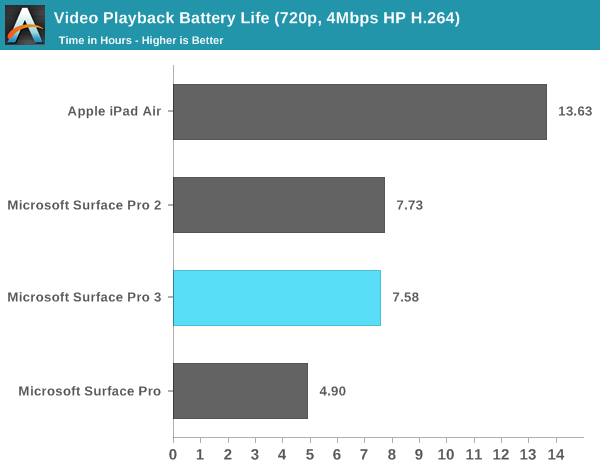
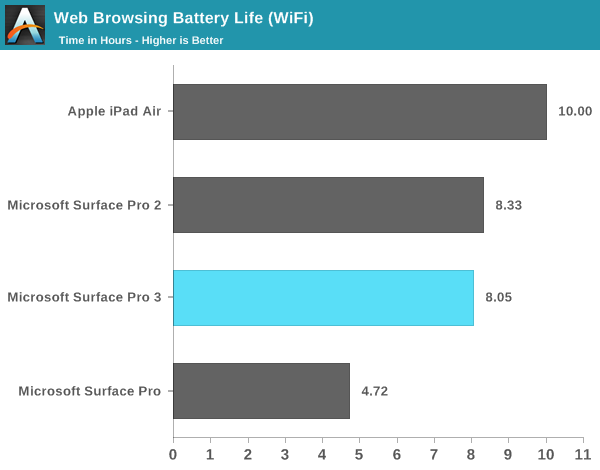


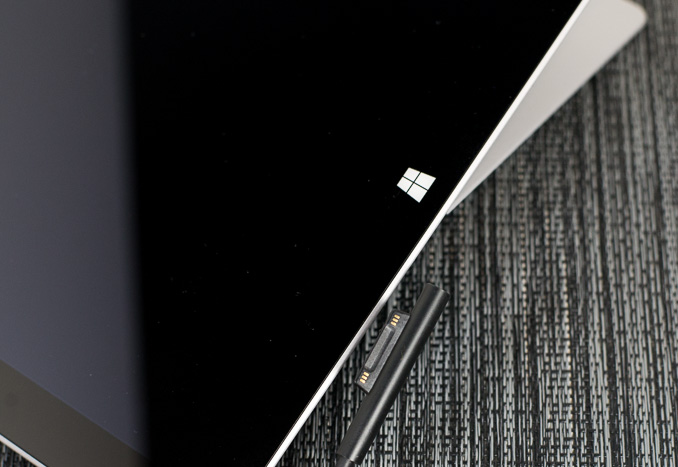
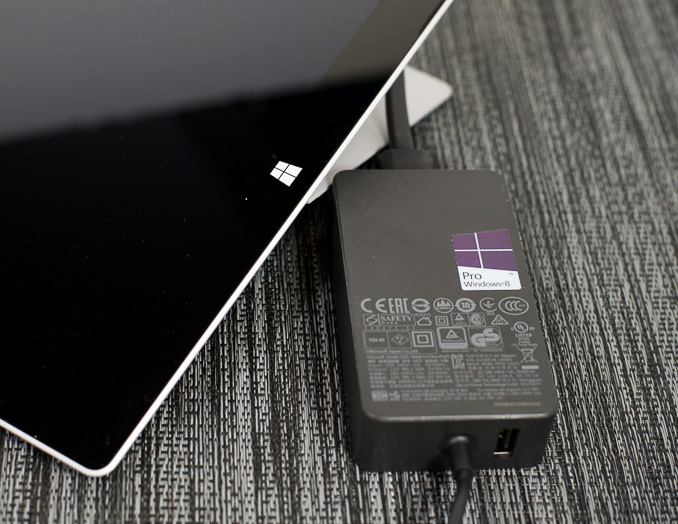








274 Comments
View All Comments
kyuu - Monday, June 23, 2014 - link
Problem with the rigid keyboard attachment ala the Transformer is that it only works when you have the keyboard attached. If you want to use it just as a tablet, you suddenly have no way to prop the device. It also adds much more weight and bulk.It does seem like it'd be a good idea to offer something like that as an optional attachment, especially since they insist on continuing to package and sell the type cover as an add-on.
ymcpa - Monday, June 23, 2014 - link
The only way the transformer solution works is if you have a battery in the keyboard dock that is heavy enough to support the tablet. Now you have a very heavy device, although with much longer battery life. Maybe they can introduce this as an accessory to replace the battery cover for people like you that don't care about weight.waverlybrian - Friday, June 27, 2014 - link
I don't think it's such a bad idea. Most people have some sort of kick-stand option for their iPad, which are not as good as this one. However, I do understand that you're coming from the laptop perspective. In that case I agree that MS should have partnered with a 3rd party like Logitech to come out with the heavier rigid keyboard attachment. That would have made the laptop replacement aspect of the SP3 truly complete (and given them a better reason to not include the Type Cover with the PC). With a small battery and a few ports in the base, this would really address all of the complaints from reviews that this doesn't measure up to the MBA.hughlle - Friday, June 27, 2014 - link
Yet for tablet use, the kickstand is absolutely fantastic. To hell with flimsy and unstable 2 position case stands for tablets. I'll take a kick stand any day of the week.mkozakewich - Monday, June 30, 2014 - link
I use the Surface (original) on both legs or one leg, and have never generally had problems with it.There's the rare time where I'm laying down with my knees up, and will have the tablet against my knees held up by the keyboard in my lap pressing against my stomach, and in that case I could use a bit more firmness in the link between Surface and cover, but that has nothing to do with the kickstand.
Megabusta - Monday, June 23, 2014 - link
First time poster, long time lurker. Lovely review as always. I wish I could wait for the broadwell refresh but my gigantor ASUS G73JH's GPU just bit the dust from overheating constantly and I'll be picking one of these next payday. The student discount doesn't hurt either. I don't need a portable gaming machine anymore and the design of the laptop looked a little goofy when brought into work. Going from that 8.5 lb behemoth to this 2 lb thing is going to be a big change but a welcome one for my back and shoulders.iceman-sven - Monday, June 23, 2014 - link
Nice review Anand.The Surface is pretty near, what I want. But for a workable config is to expensive for me. Or I want more for that money.
By the end of the year, we will see the first 4k tablets. So 2160 x 1440 is a little bit low for the future. I get this is mostly a Intel fault, for a bad road-map. The first good chip is properly Skylake-U.
Other missed opportunities: PCIe SSD & Thunderbolt
My next tablet is a 12-13" 4k Nvidia Tegra K1 ARMv8 or iPad Pro.
jeffkibuule - Monday, June 23, 2014 - link
You need to be careful wishing for 4K everything, because while you're eyes might not notice the screen resolution increase, your CPU, GPU and screen backlight are going to take a sizable hit to your battery life.iceman-sven - Monday, June 23, 2014 - link
I do not care, it is for more than 80% home use. So power is near by.joaoasousa - Tuesday, June 24, 2014 - link
I mostly use my tablet at home and I still cherish the fact that I don't have to keep it plugged.....